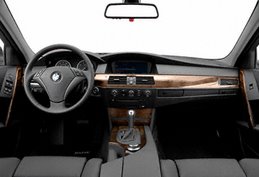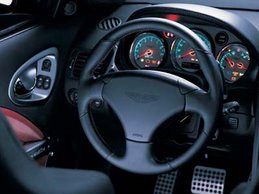 2006 Buick Lucerne CXS - Given their fame, the reign of the portholes was quite short (probably shorter than this historical digression — Ed.), 1949 through 1957. Buicks for 1958 had so many other chrome furbelows that there was no room for holes. They came back as halfhearted vestiges on a few models in the ’60s and ’70s, but no one was counting by that time. Apparently, even Buick lost the formula, because when the flagship Park Avenue Ultra was launched in 2003, it was a three-holer. Some Ultra.
2006 Buick Lucerne CXS - Given their fame, the reign of the portholes was quite short (probably shorter than this historical digression — Ed.), 1949 through 1957. Buicks for 1958 had so many other chrome furbelows that there was no room for holes. They came back as halfhearted vestiges on a few models in the ’60s and ’70s, but no one was counting by that time. Apparently, even Buick lost the formula, because when the flagship Park Avenue Ultra was launched in 2003, it was a three-holer. Some Ultra.The Lucerne is big iron by today’s standards, 6.4 inches longer than the hulking Chrysler 300, 2.5 longer than a Ford Five Hundred, but 4.4 shorter than its Cadillac DTS sibling. Apart from the reinterpreted portholes, the wedgy shape seems familiar and tired, a repeat of a ’90s Camry; only the big-eye look in front saves it from being a complete cliché. Inside is a different story, fresh and appealingly minimalist. The shapes are smooth and soft. The details are happily integrated, like a deftly done symphony. No pretentious gestures grab for your glance. The three round dials in the cluster have understated markings. Big knobs with radiused chrome edges work the stereo, HVAC, and lights.
You’re surrounded by a first-rate simulation of quality materials. In fact, the Lucerne interior is a panorama of plastic under soft-touch paints, trimmed in obviously fake wood, but someone worked hard on the details. The shines and sheens look classy, and the stitched seams across the doors, seats, and console are convincingly craftsmanlike. The windshield pillars are smoothly covered in headliner material, eliminating molding lines and distracting glare.
The rear bench is shaped for unexpectedly good thigh support, considering the shortness of the cushion, b
 ut the passenger space back there can’t compete with that of other full-sizers. Sasquatch will approve of the Buick’s wide-opening rear doors, but the carpeted walls under the front buckets will block his toes. The Chrysler 300 and the Ford Five Hundred do a better job for big-footed passengers. The fold-down center armrest has the obligatory cup-holder insert, a one-piece plastic molding created by a moonlighting Rubbermaid designer. The console between the front seats has a pair of adjustable-angle HVAC vents but no fan-speed controls.
ut the passenger space back there can’t compete with that of other full-sizers. Sasquatch will approve of the Buick’s wide-opening rear doors, but the carpeted walls under the front buckets will block his toes. The Chrysler 300 and the Ford Five Hundred do a better job for big-footed passengers. The fold-down center armrest has the obligatory cup-holder insert, a one-piece plastic molding created by a moonlighting Rubbermaid designer. The console between the front seats has a pair of adjustable-angle HVAC vents but no fan-speed controls.Although a V-8 driving the front wheels is out of step with today’s trend back to rear drive, the Lucerne makes it seem as right and righteous as God’s plan. What torque steer? More to the point, what torque? For the record, the 4.6-liter Northstar is a twister, not a torquer, delivering 275 horsepower at 5600 rpm, with another 1000 rpm available before the redline, but a torque output of only 290 pound-feet at 4400 rpm. Compared with, say, the 390 pound-feet at 4000 rpm of Chrysler’s Hemi, the Lucerne’s V-8 is only mildly energetic.
From a standing start, you get an initial jump off the torque converter up to 7 or so mph, followed by a sag as you wait for the twister V-8 to take over, which it does at about 28 mph; 60 mph comes up at just a tick under seven seconds (6.9), followed by the quarter-mile mark in 15.3 at 94 mph.
The CXS comes standard with GM’s Magnetic Ride Control adaptive shock absorbers and StabiliTrak stability system. This is a quiet car but not a marshmallow over the bumps, and there’s just enough shake in the steering column and seat to remind that roads are rarely smooth. The system does a good job of limiting large up-and-dow
 n suspension motions without emphasizing the small stuff.
n suspension motions without emphasizing the small stuff.Braking from 70 mph required 177 feet, within the expected range for a sedan of this intent. Braking feel is less satisfying. The pedal is downright squishy as you wait, motionless, for the light to change. And each stop requires a push through an initial slack zone before braking gets serious.
GM has apparently done a good job of bugling the Lucerne onto the public stage; we encountered an unexpectedly large interest in the test car, all of it admittedly from buyers beyond the fashionable target-market age groups.













No comments:
Post a Comment